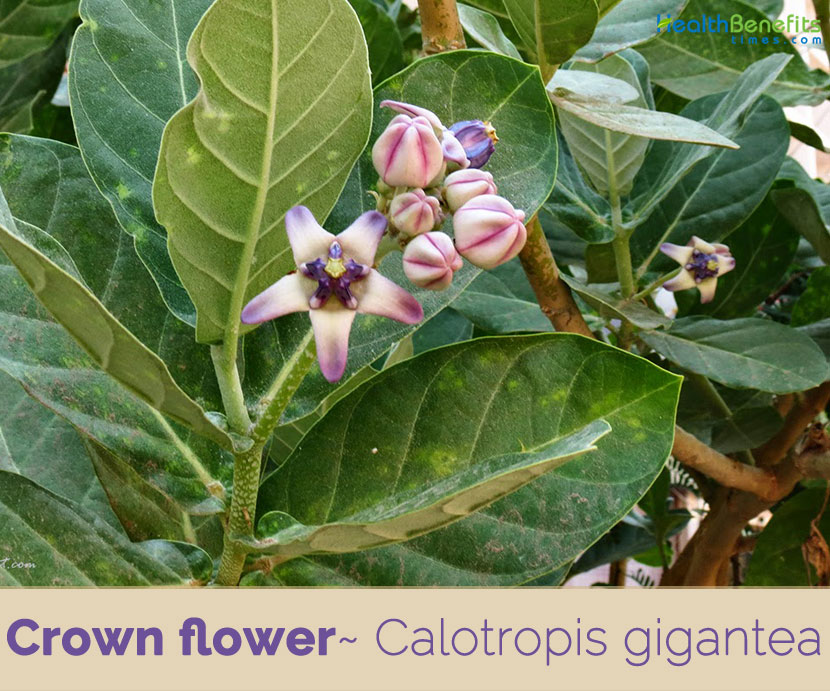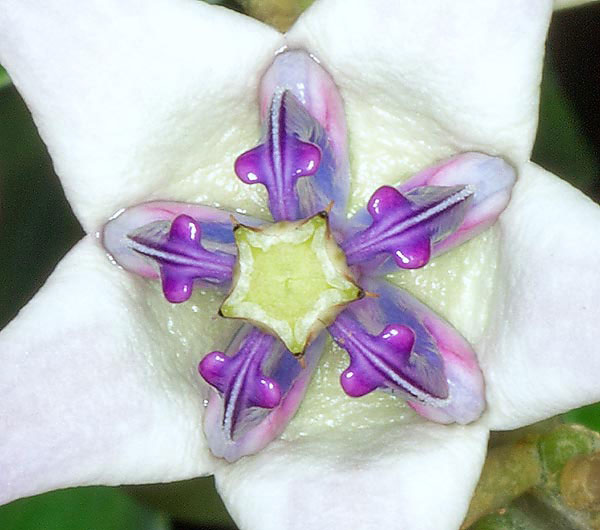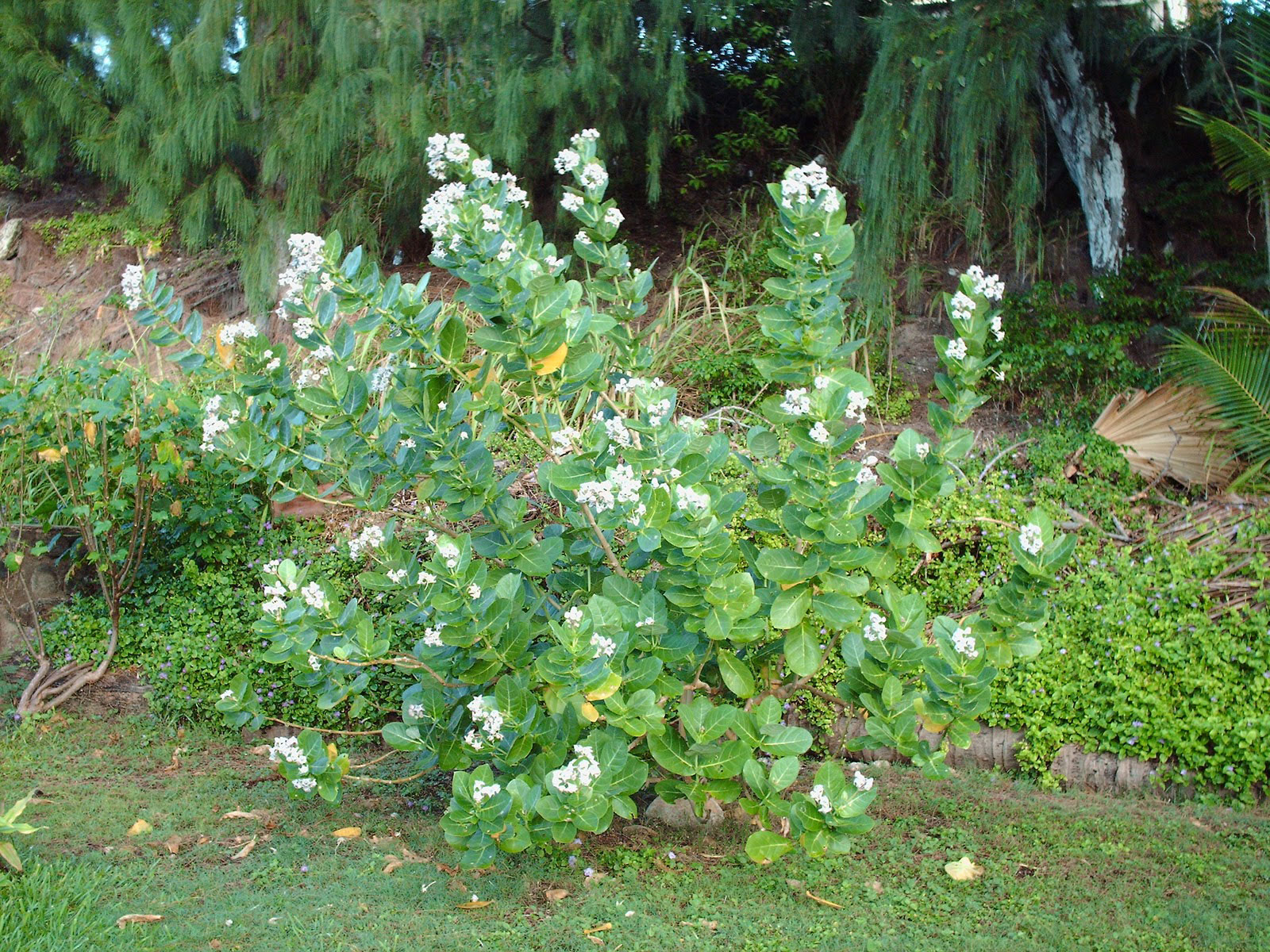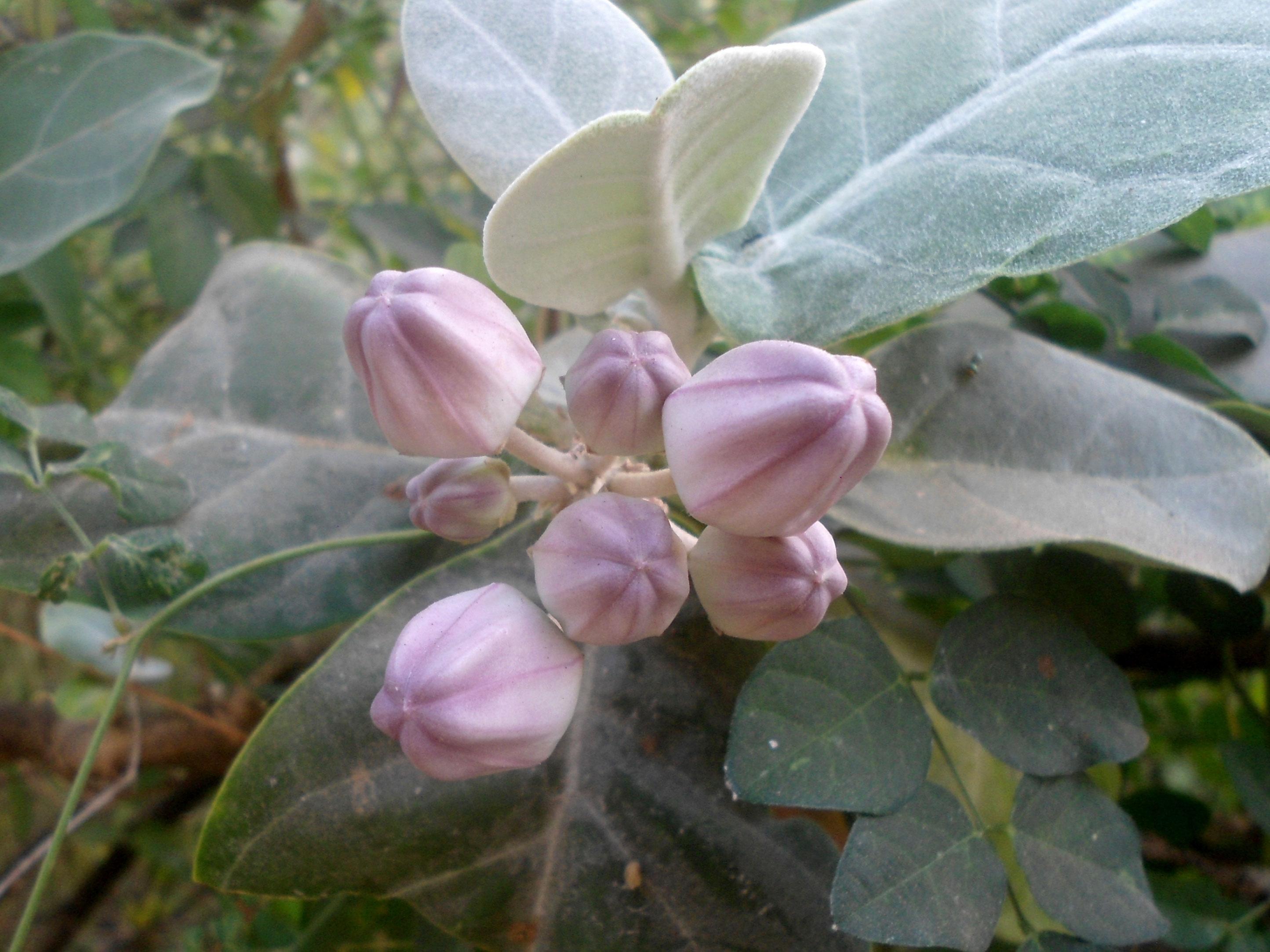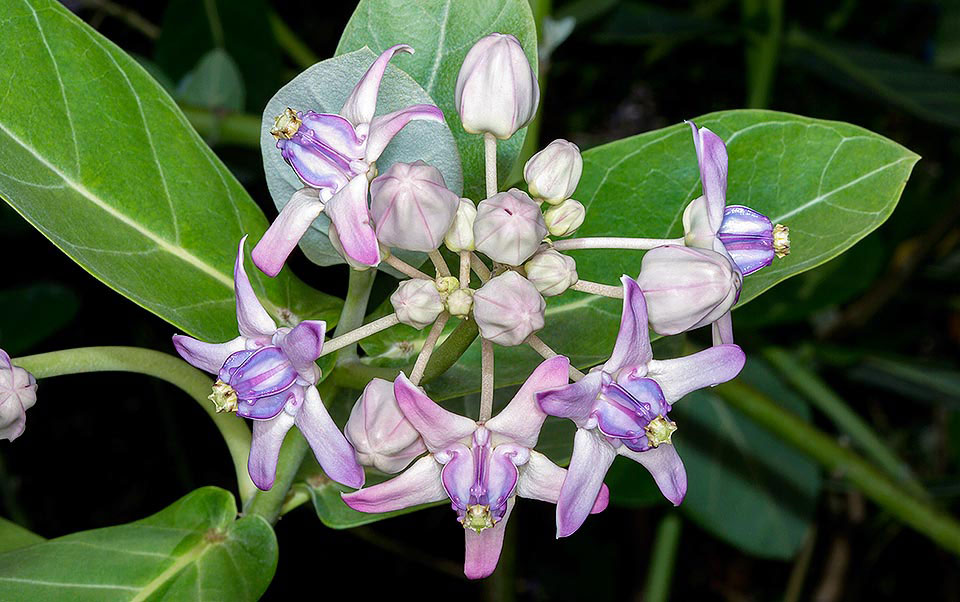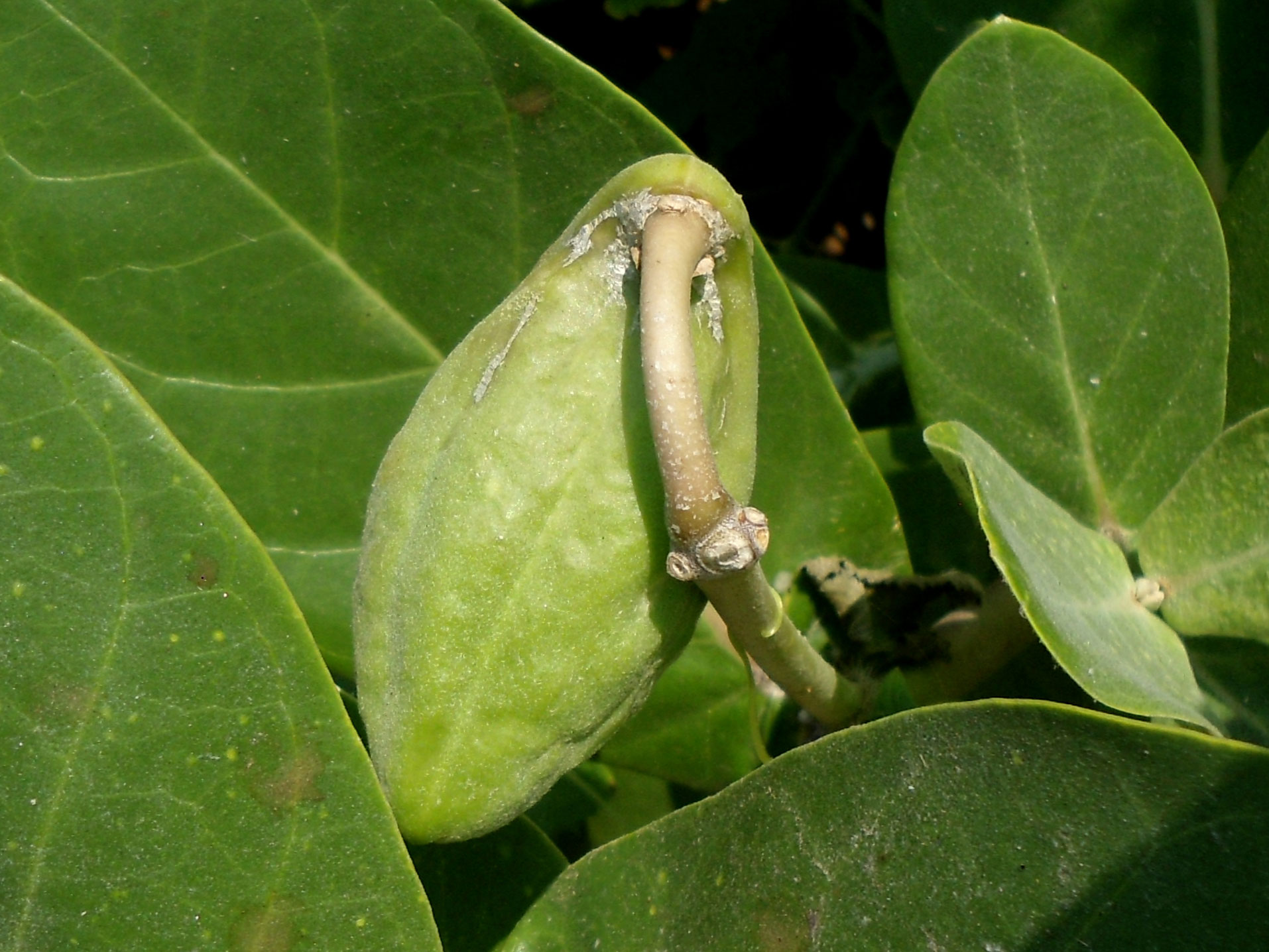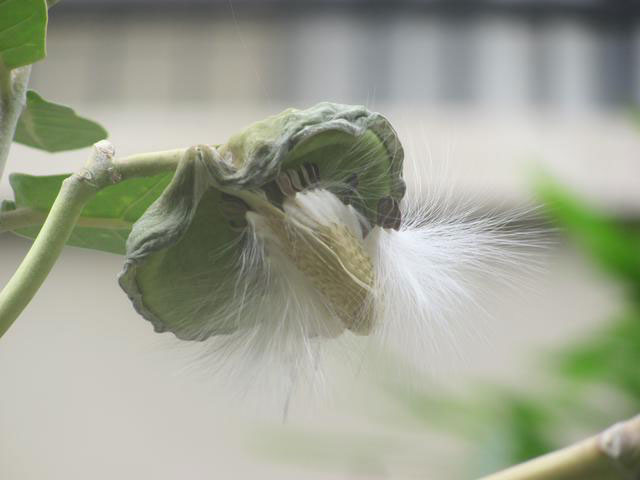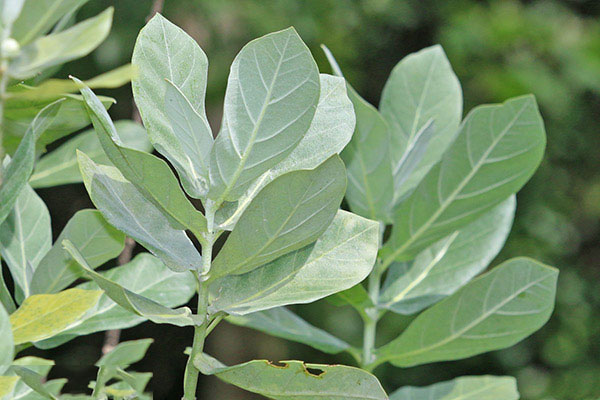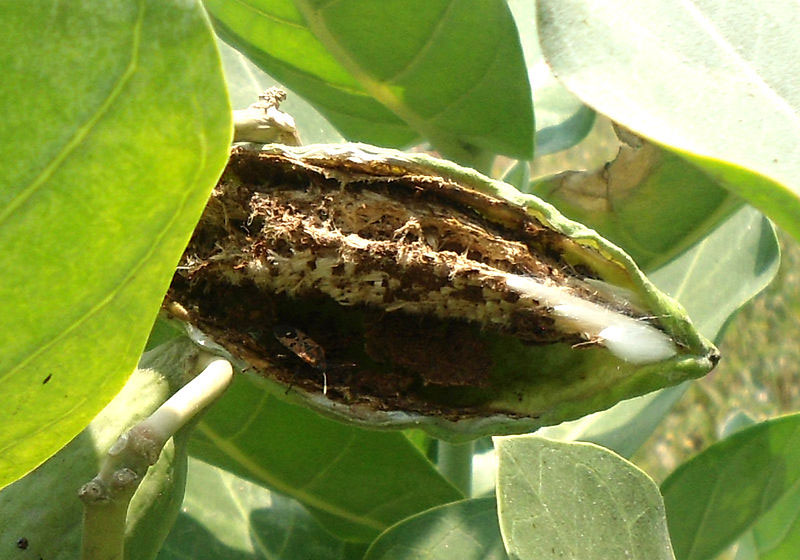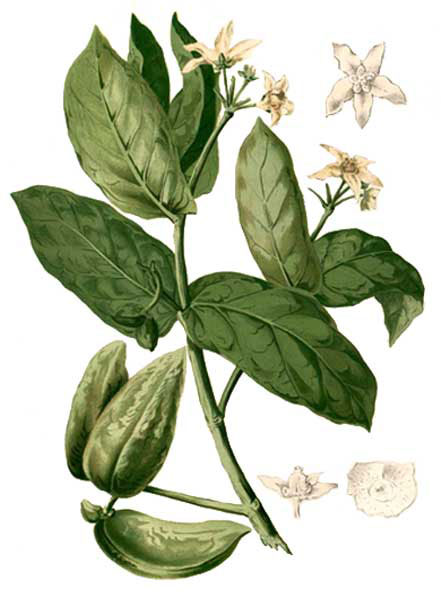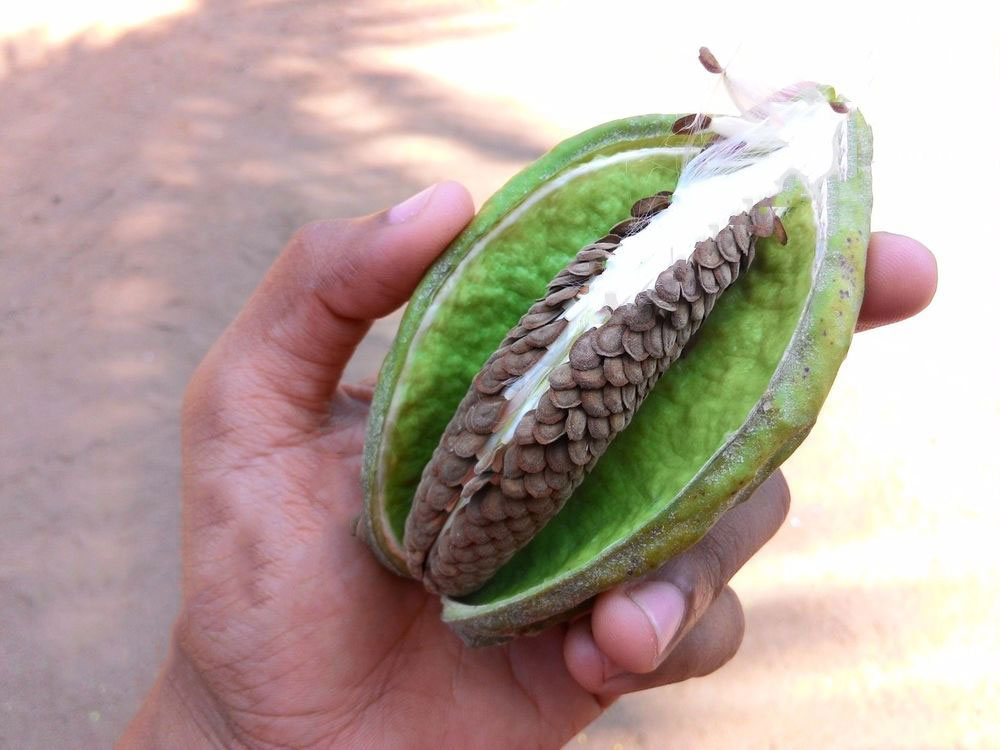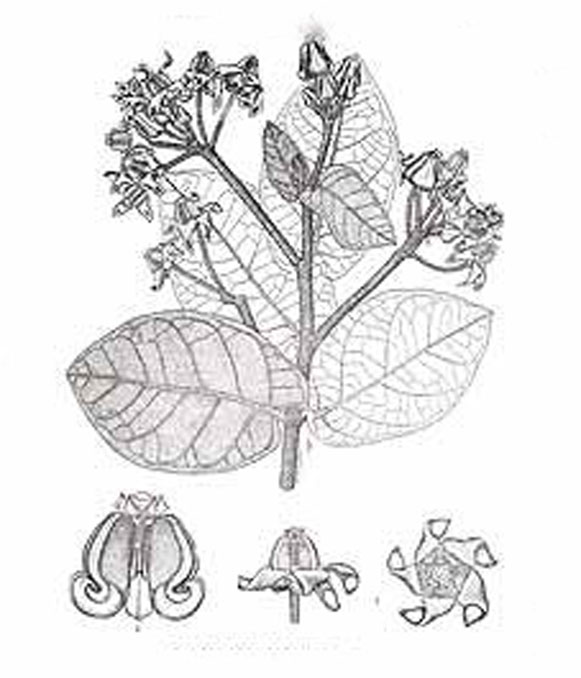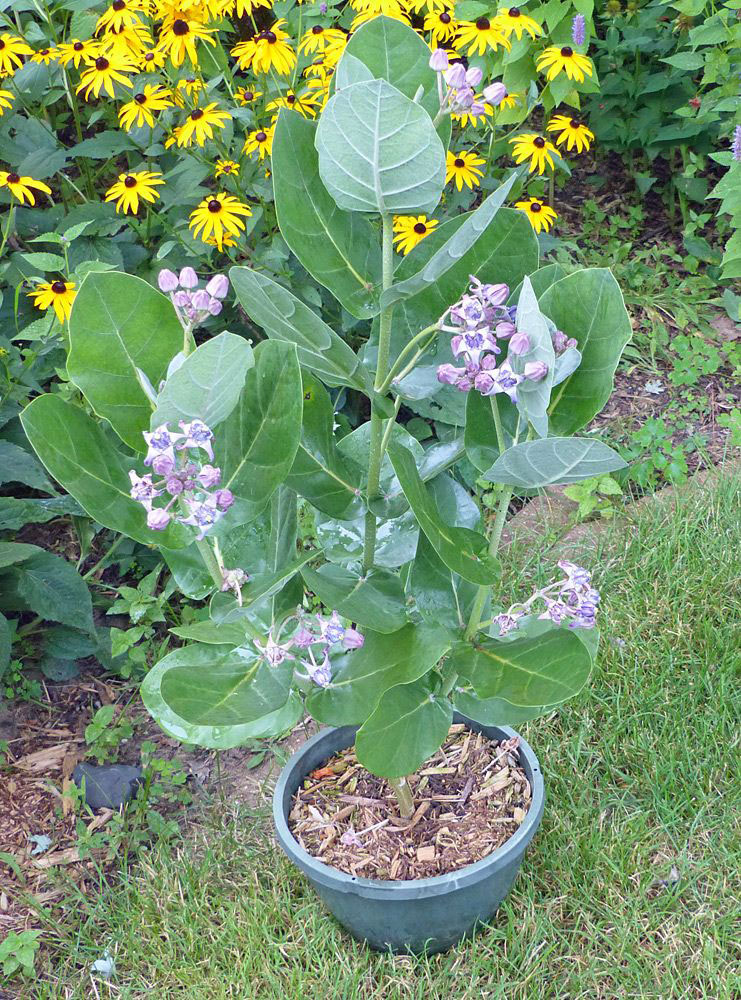| Crown flower Quick Facts | |||
|---|---|---|---|
| Name: | Crown flower | ||
| Scientific Name: | Calotropis gigantea | ||
| Origin | Continental Asia and South-East Asia and has been introduced in the Pacific Islands, Australia, Central and northern South America and Africa | ||
| Colors | Light green colored | ||
| Shapes | Pair of follicles, each follicle ovoid, boat-shaped, inflated, 6.5–10 cm long and 3–5 cm wide, many-seeded | ||
| Taste | Bitter, salty, astringent | ||
| Health benefits | Treat Diabetes, Good anti-inflammatory nature, Rid Blemishes of the skin, Treat Ear pain, Helps bowel movement, Improve speed of healing, Excellent vermifuge, Antidote for snake poison, Relief for a toothache, Relief from gastritis | ||
| S. No | Plant Parts used | Preparation | Uses |
| 1. | Whole plant | In Nigeria traditional medicine, C. gigantea is either used alone or with other herbs | To treat common diseases such as fever, rheumatism, cold, diarrhea, indigestion and eczema |
| 2. | Whole Plant | Whole plant is used | In boils and also to remove thorn from body. |
| 3. | Whole Plant | Ash of whole plant | For the treatment of jaundice |
| 4. | Whole plant | The alcoholic extracts of the root and leaves of C. gigantea | Is used as coloring material. |
| 5. | Root | Chloroform root extract of Calotropis gigantea | Were found to have anti-cancer activity against human epidermal carcinoma of the naso-pharynx tissue culture. |
| 6. | Root | Root is used as | Digestive agent |
| 7. | Root | Root is used to treat | Induced acute and chronic liver injury by carbon tetrachloride. |
| 8. | Root | Extract of root is taken orally by the tribal ladies. | Hydrocede, in headache, severe body pain, malarial fever and convulsion |
| 9. | Root | The root powder is mixed with butter and this ointment is applied to. | Eczema, leprosy, elephantiasis, asthma, cough and rheumatism. |
| 10. | Root | given with black pepper | To relieve filarial |
| 11. | Root | The paste of root bark | In dysmenorrhea, Dysentery. |
| 12. | Root | The root bark powder is used | Rabid dog bite and on the paralyzed limbs |
| 13. | Root bark | Root bark powder | Protracted labor and also used for spleen complaints, elephantiasis, rheumatism, |
| 14. | Root bark | The bark of root is taken out and mixed with a minute dose of arsenic and given in the form of a pi | In the treatment of Diarrhea and dysentery. In case of diarrhea it changes the fecal matter into a semisolid mass with in the first day of treatment |
| 15. | Root bark | Stem used as tooth brush | Is used to treat diarrhea and dysentery and it is an excellent substitute for ipecac. |
| 16. | Root Bark | Latex is mixed with Sodium Chloride and warmed on hot slow heating. During heating continuous stirring should be done. One microgram given orally thrice a day. | Traditionally it is used to treat cholera, extracting guinea worms and indigestion. |
| 17. | Root Bark | The latex applied locally During the course of this treatment, prepared from the whole plant Swertia Chirayita is also taken. | For the treatment of skin diseases, enlargements of abdominal viscera and intestinal worms.
|
| 18. | Stem | Dried powered leaves can be dusted over wounds, ulcers and old sores | To people suffering from leprosy. |
| 19. | Stem Latex | In morning, before sunrise, tender leaves were given in a capsule with water on an empty stomach. After treatment for three days | Used as tonic, antispasmodic, and expectorant and in large doses emetic. |
| 20. | Stem Latex | Mature leaves of C. gigantea along with urine of the patient concerned are filled in an air tight earthen pot. After ten days, a cloth wet in this urine is applied on | To enhance amylase activity. |
| 21. | Stem latex | Leaves of Calotropis gigantea are used
|
As Tooth brush having the property of curing toothache |
| 22. | Stem Bark | Leaves used as | To the patient of tuberculosis |
| 23. | Leaves | Leaf extracts mixed with oil on heat.
Leaves are smoked. Leaf and black pepper used |
To cure Leucoderma |
| 24. | Leaves | Young leaves are crushed and the juice is expressed on the palms of the person venomated. It is allowed to be there for five minutes and is sniffed. If immediately sneezing starts the snake is declared to be poisonous | As an antidote in rabies |
| 25. | Leaves | Milk of goat feeding on leaves of C. gigantea is given to infants | Used as tonic and stimulant. |
| 26. | Leaves | The fresh leaves of the plant are warmed and are applied as poultice | To prompt healing. |
| 27. | Leaves | Leaves are pounded with castor oil and banded over knee joints | All patients suffering from migraine headaches got relief. |
| 28. | Leaves | Fresh leaves are roasted in the ghee or oil and applied on the | As a nematicide in vitro and in vivo. |
| 29. | Leaves | leaves mixed with turmeric, honey and karanji was applied as a paste | Bones/ parts affected from Sinus fistula. |
| 30. | Leaves | Powder of 5g dried leaves mixed with gur given orally before sunrise for 5 days. | To treat fever
|
| 31. | Leaves | Leaf latex is externally applied twice a day for 2-3 days | Hydrocede, headache, severe body pain, malarial fever and convulsion. |
| 32. | Leaves | Leaf latex is used to | Used for joints and waist pain |
| 33. | Leaves | Small quantity of fresh latex is applied over | For asthma |
| 34. | Leaves | Leaf latex is used as antidote | To cure malarial fever. |
| 35. | Leaves | Calotropin isolated from latex is used as a remedy for | Eczema, leprosy, elephantiasis, asthma, cough and rheumatism. |
| 36. | Leaves | Latex is anti-syphilitic and is also | To confirm whether the snake that had bitten the person was poisonous or not |
| 37. | Leaves | Milky latex is locally applied in the treatment of | To cure asthma. |
| 38. | Leaves | Preparations from latex with honey are used as | In rheumatism, gout and to relieve pains. |
| 39. | Leaves | Latex is applied | Against rheumatism, asthma and also used as sedative. |
| 40. | Leaf latex | Latex is, either taken internally or locally to the mouth of uterus with the aid of a stick well coated with juice. | To get relief from joint pain. |
| 41. | Leaf Latex | A single dose of the aqueous suspension of the dried latex was effective to a significant level against the | To apply on ulcers |
| 42. | Leaf Latex | Topical application of 20 micro liters of 1% sterile solution of the latex of Calotropis gigantea twice daily for 7 days | For washing clothes. |
| 43. | Leaf Latex | Pills of a black gram size are made from one tablespoonful of latex mixed with 20g sugar and 1g calcium carbonate. One pill twice a day given for three days is said | Swelling part of body. |
| 44. | Leaf Latex | Latex of the plant is filled in spaces between nails and finger tips of patient twice daily for a few days to cure conjunctivitis. | To cure flatulence, anorexia, indigestion and intestinal worm infestation |
| 45. | Leaf Latex | Latex is applied | On the wounds |
| 46. | Latex | Latex is used | To cure migraine |
| 47. | Latex | Take 26 gm. of lahori salt, put it in an earthen pot, add Calotropis milk so that the salt dipped in to it, and cover earthen pot mouth and heat up. Grind it and use the powder externally for gum bleeding with small amount of HCL. It is effective for | Sores, skin diseases, inflammation and rheumatic joints |
| 48. | Latex | 4 to 5 drops of fresh latex of the plant is dropped over the injured portion as an antiseptic in the | To treat pain in any part of the body |
| 49. | Latex | Used as | Treat scorpion and snake bite. Leaf latex is applied on bitten area. |
| 50. | Latex | Latex is topically used as | The wart affected area. |
| 51. | Latex | Latex of Calotropis gigantea and Mangifera indica mixed with one drop of conc. HCL is applied locally as an | For Scorpion bite. Fresh leaves are cut and the excluding latex applied to affected area. |
| 52. | Latex | Latex and leaves mixed with turmeric, honey and karanji was applied as a paste. | Black scars on face; boils, cold, cough, asthma, ear ache, eczema, skin eruptions, inflammatory lesions, pain of the body, rheumatism, syphilis, leprosy and edema. |
| 53. | Latex | Pills of the size of a black gram are made from the paste obtained by mixing 6gm flower buds with 7-8 black pepper seeds and 3gm salt. Two pills are given twice daily for three days. | Inserted in to painful tooth cavities and applied to various skin complaints. |
| 54. | Latex | Internal part of flower and sugar used for | Cutaneous diseases such as ringworm, syphilitic sores and leprosy. |
| 55. | Latex | Powder of dried flowers of Calotropis gigantea grind along with Papaver somniferum and Eletteria cardomomum (20gm each), called Tally, used three times daily (about one teaspoonful) | Anti-rabies and also in the treatment of toothache and cough. |
| 56. | Latex | The leaves and flowers are crushed and the paste is mixed with honey | On ringworm and eczema, affected area becomes black after the application due to its burning effect |
| 57. | Latex | Flowers of this plant are used | Used for abortion |
| 58. | Latex | About 12 gm stigmas are added to 5-8 black pepper, 3 gm black salt and opium (equal to one seed of mustard) and make into pills of the size of black pepper. One pill three times daily to given with hot water for three times a days | Acute inflammatory response. |
| 59. | Latex | Take 3 gm. of Calotropis seeds, 18 gm. of red chili seeds and 6 gm. opium. Grind all of these and mix it in one teaspoon of ginger and half cup of onion water, if unavailable then use syrup of sugar and citrus medica water. | For wound healing potential. |
| 60. | Latex | To cure arthritis | |
| 61. | Latex | In toothache | |
| 62. | Latex | As antiseptic | |
| 63. | Flower | Gum bleeding and salt | |
| 64. | Flower | Skin infection | |
| 65. | Flower | Cholera and leprosy. | |
| 66. | Flower | Purgative and used in dysentery. | |
| 67. | Flower | Odontalgic. | |
| 68. | Flower | Various skin diseases also act as purgative. | |
| 69. | Flower | Antidote in scorpion bite. | |
| 70. | Flower | Relieve inflammation and snake bite to neutralize poison. | |
| 71. | Stigma | Tooth ache, ringworm and also for removing face darkness. | |
| 72. | Seed | Cytotoxicity of human colo-rectal carcinoma cell line and displayed the strong cyto-toxic activity | |
| In malaria fever | |||
| To get relief from migraine. | |||
| Abdominal diseases and asthma. | |||
| To remove dandruff from the hair. | |||
| To cure cholera and severe dysentery. | |||
| To cure flatulence, anorexia, indigestion and intestinal worm infestation. | |||
| In piles and asthmatic problems. | |||
| To treat cholera. | |||
| It is useful in cholera |
Percentage of ethno medicinal uses of different plant parts of C. gigantea against total number of uses
| Plant Parts | Number of Uses | Percentages of Uses |
| 1. Whole Plant | 4 | 5.19 |
| 2. Root | 10 | 12.98 |
| 3. Root Bark | 6 | 7.79 |
| 4. Stem | 2 | 2.59 |
| 5. Stem Latex | 2 | 2.59 |
| 6. Leaf | 19 | 24.67 |
| 7. Leaf Latex | 3 | 3.89 |
| 8. Latex | 22 | 28.57 |
| 9. Flower | 7 | 9.09 |
| 10. Stigma | 1 | 1.29 |
| 11. Seed | 1 | 1.29 |
Health benefits of Crown flower
Listed below are some of the well-known health benefits of using Crown flower
1. Treat Diabetes
It is curious to know that Crown flower has certain anti-diabetic agents that are hailed for having the good influence on Diabetes. Recent study quote that the leaves and flower of Crown flower have some potential anti-diabetic agents that can treat diabetes with ease. It has certain properties that can enhance the sensitivity of insulin and stimulate the production of inulin simultaneously.
2. Good anti-inflammatory nature
The anti-inflammatory nature of Crown flower helps us treat inflammatory diseases such as gout and rheumatism. Warm the crushed leaves and apply it on painful joints for immediate relief.
3. Rid Blemishes of the skin
You may apply the latex of the plant mixed with turmeric to the facial skin to get rid of discoloration and blemishes. You can add suitable churna and cure vitiligo.
4. Treat Ear pain
To get a cure for ear disorders or pain in the ear, use yellow Crown flower leaves. Wash the leaves in water and extract the juice after you dry them. To 1 tablespoon of the juice, add 1 tablespoon of sesame oil. Add Cinnamon, asafoetida, calamus, and garlic (1/4 teaspoon each) to the mixture.
Cool, strain, and store it for use as ear drops. Or, you can use the leaves roasted with ghee to make the juice. Then, use it as ear drops. You can also cure deafness by taking the juice from a yellow leaf and putting it in the ear.
5. Helps bowel movement
The preparations of the Crown flower plant help ease constipation.
6. Improve speed of healing
Calotropis Gigantea helps improve the healing of the superficial wounds on the skin.
7. Excellent vermifuge
Like the flower, the Crown flower’s leaves also find use in curing worm infestations.
8. Cure for boils
Take the latex of the Calotropis Gigantea tree. Mix it with turmeric and apply it on the affected area.
9. Hypoglycemic effect
The Crown flower leaves find a use for controlling the high levels of sugar in the blood.
10. Vomit therapy
Latex of the Crown flower’s leaves can cause vomiting and purgation. Hence, it finds use in purgation and vomiting therapy.
11. Cure foot blister
You get immediate relief for foot blister by applying the latex of the Crown flower tree.
12. Cure cholera
Take the dried bark of the Crown flower plant and powder it. To this, we add pepper powder and ginger juice. We roll it into small tablets the size of a pea. Take the tablet every two hours with mint juice. This will help cure the fever.
13. Antidote for snake poison
During the olden times, people chewed the leaves of the Calotropis Gigantea plant and applied the latex over the wound of a snake bite.
14. Relief for a toothache
We apply the latex on the gums to get relief from a toothache.
15. Relief from gastritis
They process the leaves of the Crown flower plant and use it to get relief from gastritis.
16. Cure for chronic diarrhea and indigestion
Use the preparations of the Crown flower plant to cure diarrhea that is long lasting. It settles the stomach and helps augment the digestive process.
17. Use as an abortifacient
Milky discharge of the Crown flower plant is an abortifacient. So, women who want to abort their child will use the latex preparations.
18. Spasmogenic property
The preparations of the plant are capable of Spasmogenic effect. So, it finds use in the treatment of a variety of diseases.
19. Treat sexually transmitted diseases
People use the white flowers of the Crown flower plant for treating diseases such as syphilis.
20. Good anti-fungal property
You can treat diseases such as candida by using the Sodom plant preparations. The medicine can prove poisonous if you overdose so be careful.
Traditional uses and benefits of Crown flower (Sodom)
- The plant reportedly has antifungal and insecticidal properties.
- In traditional medicine, crown flower is used as treatment for common diseases such as fever, coughs and colds, eczema, rheumatism, nausea, and diarrhea.
- Latex is also used for treatment for sprains, boils, body pains, and pimples.
- Milky sap (latex) clots when warm and is said to have similar cardiac properties to digitalis (from various Digitalis spp.).
- It is used in the treatment of a variety of other conditions including dysentery, leprosy, elephantiasis, epilepsy, asthma and many other complaints.
- Mixed with salt, it is taken orally as an emetic for treating severe colds.
- Latex is applied to sprains, body pains, boils and pimples in Nepal.
- Milky latex is used externally to stop bleeding, and for treating a wide range of conditions including leprosy, rheumatism, ringworm, boils, scabies, stings, burns, bruises, cuts, sores and wounds.
- It is applied to the gums and teeth to treat caries and toothaches.
- Bark is used as a medicine for the treatment of neuro dermatitis and syphilis.
- Powdered bark is used to treat diarrhea, dysentery, elephantiasis, and leprosy.
- Stem bark is diaphoretic and expectorant, and is used for dysentery, spleen complaints, convulsions, lumbago, scabies, ringworm, pneumonia, and to induce labor.
- An infusion of the leaves is used to treat severe chest colds and heart conditions.
- Leaf juice is used in the treatment of intermittent fever.
- Smoke of dried, burned leaves is inhaled to calm asthma attacks.
- Crushed leaves are warmed and used as a poultice on sores, burns, headaches and rheumatic pains.
- Powdered flowers are valued for treating coughs, colds and asthma.
- An infusion is taken to treat intestinal worms, rheumatism and epileptic attacks.
- Juice of young buds is dropped into the ear in the treatment of earache.
- Sap is used in treating leprosy and as a purgative.
- Bark and Latex is used to treat skin diseases and as a vermifuge.
- Root bark has been substituted for ipecac, especially to treat dysentery; also used in treating skin disease.
- Bark of the species is used as a medicine for the treatment of neuro dermatitis and syphilis, and the leaves are used as a poultice in China.
- Young fruits are boiled in water and a paste prepared which is applied on the body to remove blood clots.
- Latex obtained from the plant is used to induce vomiting as well as purgation.
- It helps in relieving bloating, flatulence and abdominal distension as a result of improper digestion of food.
- It is also effective in treating ascites in which there can be large abdominal distension due to the accumulation of fluid in the abdominal region.
- It improves appetite thus fighting anorexia and disinterest in consuming food.
- It helps in healthy working of the respiratory system, helping in diseases like common cold, cough, asthma and other similar respiratory problems.
- Leaves and latex are used as an antidote for snake poison.
- Leaves can be boiled and used as a hot poultice to relieve stomach pains, headaches and sprains.
- Tincture made from the leaves is said to be good for fevers.
- Parts of the plant are also given as an aphrodisiac and a sedative, and as it was found to stimulate the blood flow, it probably can help men with erectile dysfunctions.
- Skin from the root is used in decoction for skin problems.
- Root was used for the treatment of eczema, leprosy, elephantiasis, asthma, cough, rheumatism and diarrhea.
- Tender leaves of C. gigantea are also used to cure migraine.
- It is also used as a remedy for black scars of face, boils, cold, cough, asthma, ear-ache, eczema, skin eruptions, inflammatory lesions, pains, rheumatism, syphilis, leprosy and edema.
- It has also been used as an antiseptic for skin infection, laxative, ear drops and anti-fertility agent.
- Root bark and leaves have been used by various tribes of central India as a curative agent for jaundice.
- In Ayurveda, Indian practitioners have used the root and leaf in asthma and shortness of breath and the bark in liver and spleen diseases.
- Plant is reported as effective in treating skin, digestive, respiratory, circulatory and neurological disorders and was used to treat fevers, elephantiasis, nausea, vomiting, and diarrhea.
Ayurvedic Health benefits of Crown flower
- Ascites: Apply the latex of Sodom locally on the affected areas.
- Leprosy: Use the latex of Sodom plant on the affected skin.
- Leucoderma: Apply the latex of Sodom on the skin patches.
- Ringworms: Apply the milky fluid of Sodom plant over infected skin.
- Stings: Locally apply the milk fluid of Sodom plant on the damaged skin.
- Deafness: Take a ripe yellow leaf of Sodom. Warm it. Squeeze the leaf juice drops in ears. Use it for 2 weeks.
- Caries: Apply the latex of Sodom on the affected teeth.
- Gastroenteritis: Roast the leaves of Sodom and apply locally.
- Swelling: Apply the roasted leaves of Sodom over the affected area.
- Headache: Warm the leaves of Sodom. Tie it with cotton cloth on the forehead.
- Antidote: Chew 4 leaves of Sodom once a day. OR: Crush roots of Sodom and apply it over bitten area.
- Fever: Mix equal quantity leaf juice of Sodom with
- . Take 1 tsp. of it repeatedly after 1 hour.
- Aphthous Ulcers: Add 1 tsp. Honey in same quantity latex of Sodom. Apply it over affected areas.
- Ascaris: Consume mixture of Sodom leaf juice and Honey twice a day.
- Dental Diseases: Externally apply latex of Sodom plant over Dental Problems.
- Analgesic: Apply Latex of Sodom over painful areas.
- Tumor: Consume 3 ml root extract of Sodom. Have it once a day.
- Diabetes: Consume 1 g dry latex of Sodom twice a week.
- Liver Disease: Take some leaves and flowers of Sodom. Make its decoction. Have 10 ml of it twice a day.
- Malaria: Pluck a leaf of Sodom and collect a drop of the milky sap in a spoon. Add some palm jaggery and make a small pill. Ask the Malaria patient to swallow this pill on empty stomach. (Note: Pluck the leaf before sunrise as after sunrise that milky sap turns poisonous.)
- Abscess: Mix the latex of Sodom with Turmeric powder to make a paste. Apply it over the affected areas
- Abscess: Soak few Carom seeds in the latex of Sodom overnight. Roast the soaked seeds over flame. Grind them to make a fine powder. Mix 1 tsp. of the powder with Yogurt. Apply it on the damaged skin.
- Acne: Mix some Carom seeds with the milky sap of Sodom. Leave it overnight. Roast the soaked seeds and grind them. Mix 1 tsp. of the powder with Yogurt. Apply it on the affected areas.
- Asthma: Take equal quantities of Sodom flowers, Clove and Black Pepper. Grind them together. Mix a pinch of this mixture with lukewarm water. Drink this water once a day. (Caution: Do not use in excess as it may cause Diarrhea or Vomiting.)
- Bronchitis: Grind the root bark of Sodom. Mix it with Date Palm sugar. Take a pinch of it during bedtime with warm milk. (Caution: Excess use may cause Diarrhea.)
- Cold: Mix Date Palm sugar with Sodom root barks powder. Take 2 pinch of it with warm milk at night
- Cough: Take root bark of Sodom. Grind it to make powder. Add Date Palm sugar in it. Take quarter tsp. of the mixture with warm milk during bedtime. Use it once a day.
- Fatigue: Take mixture of Date Palm sugar and Sodom root bark powder during bed time. (Caution: Excess use may cause Vomiting.)
- Insect Bites: Make a mixture of Sodom root bark powder and Date Palm sugar by taking them in equal ratio. Take 1/4 tsp. with warm milk at night. Use it for 4 days.
- Leprosy: Take root bark powder of Sodom. Add same quantity of Date Palm sugar in it. Take a pinch of it with warm milk after dinner. (Caution: Do not use repeatedly, as it may cause Diarrhea.)
- Cholera: Grind the root and bark of Sodom to make a fine powder. Add some Ginger juice and Black Pepper. Mix properly to make a thick paste. Make pea sized pills of it. Make a decoction of Cardamom and Mint leaves. Take 1 pill with the decoction after every 2 hours. Use it for 5 days.
- Cold: Take boiled rice in a cup. Add 5 ml Sodom latex. Put it under sun to dry for 1 week. Repeat the whole process by adding 15 ml latex. Grind to make powder. Add some Camphor powder in it. Use it as snuff.
- Cough: Add 1 tsp. milky sap of Sodom in 1 cup boiled rice. Dry it under sun for 7 days. Now again add 3 tsp. latex in it and dry again. Grind to make powder. Add camphor powder in it and use as snuff.
- Colic: Take 4 g of Sodom flower, black salt and Carom seeds. Add 8 g dried Ginger in it. Grind them to make powder. Make a thick paste by adding Lime juice in it. Make small pills of equal size with it. Take 1 pill per day with warm water.
- Stomach Ache: Grind 1 tsp. of Sodom flower, black salt, Carom seeds and 2 tsp. of dried Ginger to make powder. Make dough like consistency by adding Lime juice in it. Make pills of it. Have one pill per day with warm water.
- Earache: Extract the juice of ripe yellow leaves of Sodom. Take quarter teaspoon of it and add same amount of Sesame Oil. Now, add quarter teaspoon of Sweet Flag powder, Cinnamon, Garlic and 2 teaspoon of Asafoetida powder. Boil the mixture until it gets thick. Filter it through a piece of cloth. Cool it and use as ear drops.
- Ear Discharge: Mix 3 g of each of Sodom leaves juice, Sesame Oil, powder of Sweet Flag, Cinnamon and Garlic. Add 12 g Asafoetida powder in it. Boil until it gets thick. Filter through a piece of cloth. Cool it and use as an ear drop.
- Headache: Take 500 ml of Sesame oil. Add two tbsp. of Sodom flower juice, Turmeric powder, Garlic paste, Black pepper powder each. Boil over a low flame till it thickens. Cool. Put it in a bottle. Take 3-4 tbsp. of oil and massage the scalp with it. Use thrice a week
- Asthma: Take equal quantity of Emetic Nuts, Sodom Root and Licorice. Grind them together. Have 2 pinches once a day with water.
- Cold: Take Emetic Nuts, Licorice and Sodom in equal quantity. Powder them together. Have one pinch once a day. It gives relief in Cold conditions.
- Bronchitis: Mix dried Sodom flowers, Black Pepper and Clove in 4:2:1 ratio. Grind them to make powder. Consume 3 g of it with lukewarm water.
- Earache: Take 125 gm. juice of Datura Stramonium leaves and same amount of Sesame Oil. Mix well. Boil in a tin vessel for 5 to 10 minutes on medium flame till the juice remains half. Add 5 top 6 leaves of Sodom and a pinch of salt in it. Boil till it gets a thick consistency. Strain and let it cool. Put 2 to 3 drops of this solution in the affected areas twice a day.
- Asthma: Take Ziziphus Xylopyrus roots, Sodom stem bark, Erythroxylum monogynum stem bark, Indian Kino stem bark and 10 dry Cayenne Pepper. Grind them all to make a fine powder. Consume quarter teaspoon of each of the herb powder for 3 days with 1 liter of water, once a day.
Other Facts
- Crown flower produces a durable fiber known as ‘Bowstring of India’ used in making ropes and carpets among others.
- Wood is used as fuel and made into charcoal.
- Leaves can be used for mulching, green manuring of rice fields and for binding sandy soil.
- Plant is sometimes grown as a hedge.
- Fine fiber is obtained from the bark of the stems.
- It is much used for making textiles, fishing nets and bowstrings.
- Mature seed pods consists of a large quantity of floss, which has a variety of uses it can be used to stuff pillows etc. or mixed with other fibers to make cloth.
- It is a Kapok substitute, being very water repellent it can be used as a buoyancy aid in Life Jackets or as a stuffing material.
- Floss absorbs oil whilst repelling water and so has also been used to mop up oil spills at sea.
- Candlewicks can be made from the seed floss.
- Twigs are used as chew sticks for cleaning the teeth.
- Juice is used in making a yellow dye and in tanning.
- Wood is sometimes used for fuel, but it is of poor quality.
- Good quality charcoal is obtained from the wood and can be used for making gunpowder.
- Attractive flowers are long lasting and used for floral arrangements.
- May exhibit mosquito controlling properties against Culex gelidus and Culex tritaeniorhynchus mosquitoes which serves as vectors for Japanese encephalitis.
- They were preferred by the Hawaiian Queen Liliuokalani, who considered them a symbol of royalty and wore them strung into leis.
- They are used in funerals to decorate the urn or sarcophagus and the interior of the house holding the funeral in Cambodia.
- Calotropis yields a durable fiber useful for ropes, carpets, fishing nets, and sewing thread.
- Floss, obtained from seeds, is used as stuffing.
- Fermented mixture of Calotropis and salt is used to remove the hair from goat skins for production of nari leather and from sheep skins to make leather which is much used for inexpensive book binding.
- In East Africa the wood is also used as a toothbrush.
Precautions
- Sap (latex) is somewhat poisonous.
- It is used for poisoning arrows.
- All parts of the plant are toxic, due to the presence of several cardiac glycosides.
- Plant is also known to cause allergic contact dermatitis, and the latex causes kerato-conjunctivitis.
- Parts of plant are poisonous if ingested.
- Avoid use during pregnancy and breast feeding.
- Excessive use is considered poisonous.
- Dosage of different parts of this herb should be carefully modulated as over dosage can induce severe vomiting and diarrhea in patients.
- It should not be given to children.
References:
https://www.itis.gov/servlet/SingleRpt/SingleRpt?search_topic=TSN&search_value=506010#null
http://www.hear.org/pier/species/calotropis_gigantea.htm
https://pfaf.org/user/Plant.aspx?LatinName=Calotropis+gigantea
https://www.cabi.org/isc/datasheet/16847
https://indiabiodiversity.org/species/show/32452
http://www.narc.gov.jo/gringlobal/taxonomydetail.aspx?id=8652
http://luirig.altervista.org/schedenam/fnam.php?taxon=Calotropis+gigantea
http://www.theplantlist.org/tpl1.1/record/kew-2693661
https://keyserver.lucidcentral.org/weeds/data/media/Html/calotropis_gigantea.htm
https://en.wikipedia.org/wiki/Calotropis_gigantea
https://www.monaconatureencyclopedia.com/calotropis-gigantea-2/?lang=en
https://gd.eppo.int/taxon/CTRGI
https://pdfs.semanticscholar.org/ca82/a0c618880673723a32de3433c9e5b9f73035.pdf
http://tropical.theferns.info/viewtropical.php?id=Calotropis+gigantea
https://uses.plantnet-project.org/en/Calotropis_gigantea_(PROTA)
http://www.ethnoleaflets.com/leaflets/calotrop2.htm
https://hort.purdue.edu/newcrop/CropFactSheets/calotropis.html
https://www.ejpmr.com/admin/assets/article_issue/1472639505.pdf
http://www.flowersofindia.net/catalog/slides/Crown%20Flower.html
https://plants.sc.egov.usda.gov/core/profile?symbol=CAGI11


